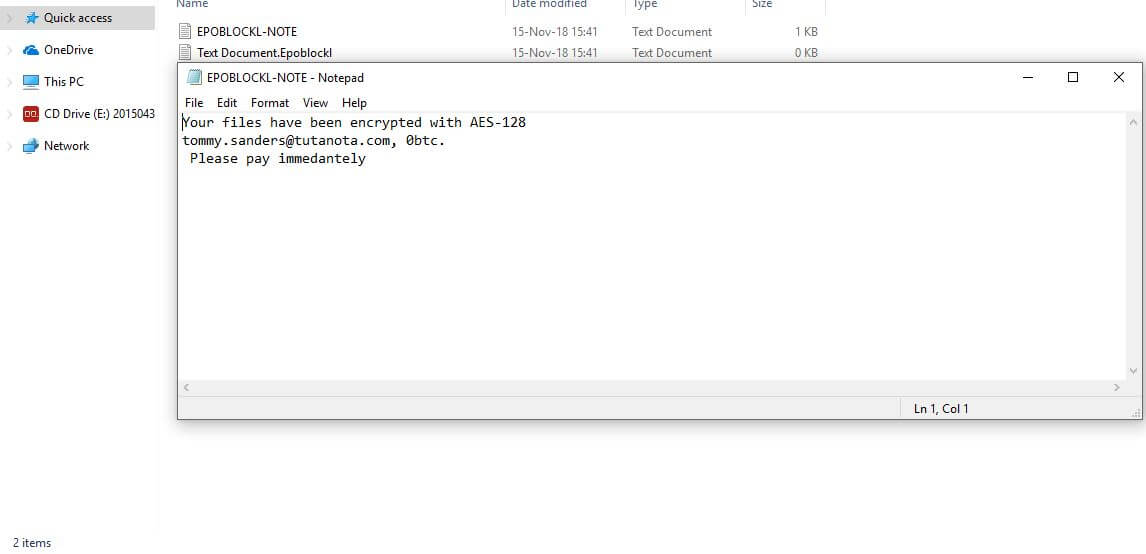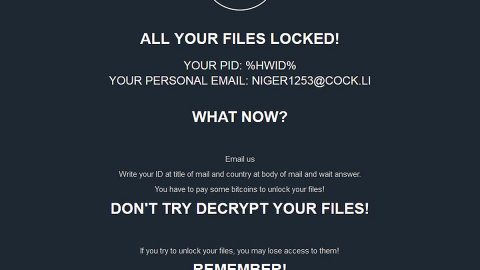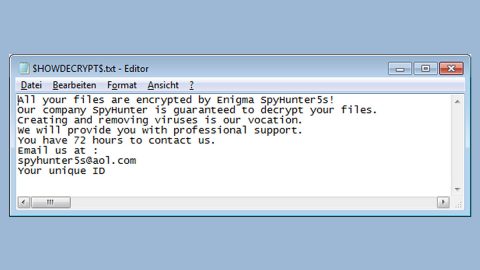What is Epoblockl ransomware? And how does it carry out its attack?
Epoblockl ransomware is a cryptovirus that was first identified on November 14, 2018. Based on the analysis done on this crypto-malware, it is created using the HiddenTear open-source platform and seems to be a variant of SYMMYWARE ransomware which was also released in the same month.

Once it carries out its attack, Epoblockl ransomware connects the infected computer to a remote Command and Control (C&C) server controlled by the attackers. From this remote server, Epoblockl ransomware downloads its other malicious components and places them on system folders. These malicious components are then used for the data harvesting module where it scans the computer for variables used to construct a unique ID associated with each individual host such as hardware components installed, user settings, and operating system environment.
This module also looks for strings that can directly expose the identity of the user like their real names, email address, location, phone number, as well as stored account credentials. The collected data is used for the second module, stealth protection, which is used to bypass the security services installed in the system. The stealth protection module is done by scanning the computer for any digital signatures of antivirus engines, sandbox environments, and virtual machine hosts. Once it finds these programs, it will disable them and if it’s not able to do so, it deletes them altogether. And for the additional measures, Epoblockl ransomware also creates memory-guarded spaces.
Epoblockl ransomware is also found to modify files in the Chrome extension folder where it may manipulate some browser extensions installed. Moreover, this crypto-virus also modifies and creates some entries in the Windows Registry. It is found to modify the following registry entries:
- HKEY_LOCAL_MACHINE\SOFTWARE\Microsoft\Tracing\RASAPI32
- HKEY_LOCAL_MACHINE\SOFTWARE\Microsoft\Tracing\RASMANCS
- HKEY_CURRENT_USER\Control Panel\Desktop\
- HKEY_USERS\.DEFAULT\Control Panel\Desktop\
- HKEY_LOCAL_MACHINE\Software\Microsoft\Windows\CurrentVersion\Run
- HKEY_CURRENT_USER\Software\Microsoft\Windows\CurrentVersion\Run
- HKEY_LOCAL_MACHINE\Software\Microsoft\Windows\CurrentVersion\RunOnce
- HKEY_CURRENT_USER\Software\Microsoft\Windows\CurrentVersion\RunOnce
After it the registry modification, it scans the system for files with the following extensions:
.7z, .asp, .aspx, .avi, .bc6, .bc7, .bkf, .bkp, .cas, .cer, .csv, .d3dbsp, .doc, .docx, .fos, .gdb, .gho, .hkdb, .hplg, .html, .hvpl, .ibank, .icxs, .itdb, .itl, .itm, .m4a, .map, .mdb, .mdbackup, .mddata, .mov, .mp4, .odt, .php, .pkpass, .png, .ppt, .pptx, .psd, .qdf, .qic, .rar, .sb, .sid, .sidd, .sidn, .sie, .sis, .sql, .sum, .svg, .syncdb, .t12, .t13, .tax, .vdf, .wma, .wmo, .wmv, .xls, .xlsx, .xml, .zip, .ztmp
Once it finds its targeted files, it encrypts them using the AES 128 encryption algorithm and appends either the .Epoblockl or .Crypted extensions. It then drops and opens a text file named “EPOBLOCKL-NOTE.txt” which contains the following message:
“Your files have been encrypted with AES-128
[email protected], 0btc.
Please pay immediately”
How is the payload file of Epoblockl ransomware distributed over the web?
This HiddenTear strain is being distributed by an unknown hacker or cyber-criminal group all over the web. The detected attack campaigns appear to be launched mainly from the United States to other countries and regions that are mainly in Northern Europe.
Refer to the removal instructions laid out below to successfully wipe out Epoblockl ransomware from your computer.
Step_1: Tap Ctrl + Shift + Esc keys to launch the Task Manager.
Step_2: Go to Processes and look for the malicious processes of Epoblockl ransomware like Epoblockl.exe. Note that these processes usually take up most of the CPU power so once see an unusual process, right-click on it and select End Process or End Task.
Step_3: Close the Task Manager and open Control Panel by pressing the Windows key + R, then type in appwiz.cpl and then click OK or press Enter.
Step_4: Look for dubious programs that might be related to Epoblockl ransomware and then Uninstall it/them.
Step_5: Tap Win + E to launch File Explorer.
Step_6: After opening File Explorer, navigate to the following directories below and look for Epoblockl ransomware’s malicious components like 032d634ef17ed5850ef6d6b43e8fe567c3d20b48e2779fd64f5a37faea2f0d34.bin.exe, Epoblockl.exe, Epoblockl.pdb, EPOBLOCKL-NOTE.txt, and other suspicious-looking files and then remove them all.
- %TEMP%
- %APPDATA%
- %DESKTOP%
- %USERPROFILE%\Downloads
- C:\ProgramData\local\
Step_7: Close the File Explorer.
Before you proceed to the next steps below, make sure that you are tech-savvy enough to the point where you know exactly how to use and navigate your computer’s Registry. Keep in mind that any changes you make will highly impact your computer. To save you trouble and time, you can just use Restoro, this system tool is proven to be safe and excellent enough that hackers won’t be able to hack into it. But if you can manage Windows Registry well, then by all means go on to the next steps.
Step_8: Tap Win + R to open Run and then type in Regedit in the field and tap enter to pull up Windows Registry.
Step_9: Navigate to the listed paths below and look for the registry keys and sub-keys created by Epoblockl ransomware.
- HKEY_LOCAL_MACHINE\SOFTWARE\Microsoft\Tracing\RASAPI32
- HKEY_LOCAL_MACHINE\SOFTWARE\Microsoft\Tracing\RASMANCS
- HKEY_CURRENT_USER\Control Panel\Desktop\
- HKEY_USERS\.DEFAULT\Control Panel\Desktop\
- HKEY_LOCAL_MACHINE\Software\Microsoft\Windows\CurrentVersion\Run
- HKEY_CURRENT_USER\Software\Microsoft\Windows\CurrentVersion\Run
- HKEY_LOCAL_MACHINE\Software\Microsoft\Windows\CurrentVersion\RunOnce
- HKEY_CURRENT_USER\Software\Microsoft\Windows\CurrentVersion\RunOnce
Step_10: Delete the registry keys and sub-keys created by Epoblockl ransomware.
Step_11: Close the Registry Editor.
Step_12: Empty your Recycle Bin.
Try to recover your encrypted files using the Shadow Volume copies
Restoring your encrypted files using Windows Previous Versions feature will only be effective if Epoblockl ransomware hasn’t deleted the shadow copies of your files. But still, this is one of the best and free methods there is, so it’s definitely worth a shot.
To restore the encrypted file, right-click on it and select Properties, a new window will pop up, then proceed to Previous Versions. It will load the file’s previous version before it was modified. After it loads, select any of the previous versions displayed on the list like the one in the illustration below. And then click the Restore button.
Congratulations, you have just removed Epoblockl Ransomware in Windows 10 all by yourself. If you would like to read more helpful articles and tips about various software and hardware visit fixmypcfree.com daily.
Now that’s how you remove Epoblockl Ransomware in Windows 10 on a computer. On the other hand, if your computer is going through some system-related issues that have to get fixed, there is a one-click solution known as Restoro you could check out to resolve them.
This program is a useful tool that could repair corrupted registries and optimize your PC’s overall performance. Aside from that, it also cleans out your computer for any junk or corrupted files that help you eliminate any unwanted files from your system. This is basically a solution that’s within your grasp with just a click. It’s easy to use as it is user-friendly. For a complete set of instructions in downloading and using it, refer to the steps below
Perform a full system scan using Restoro. To do so, follow the instructions below.













